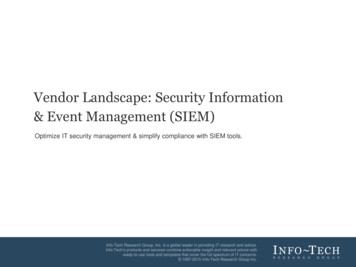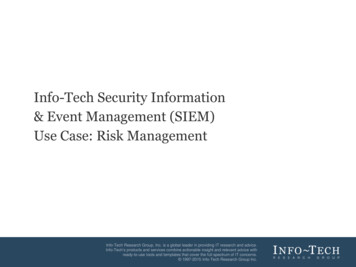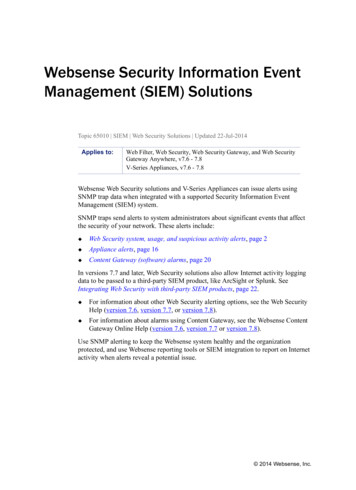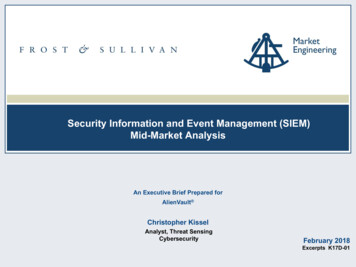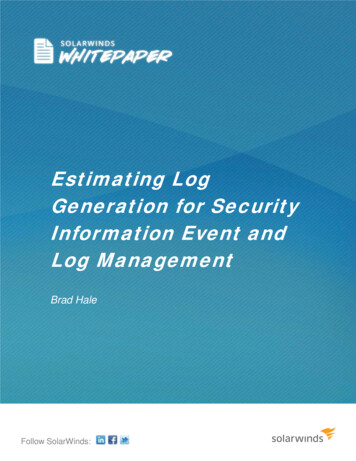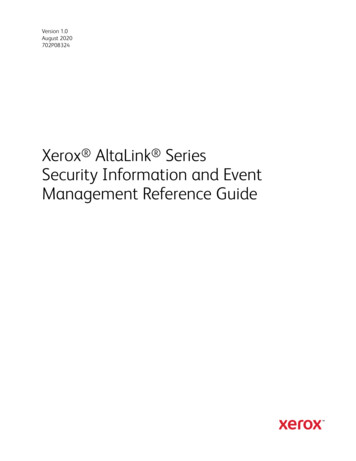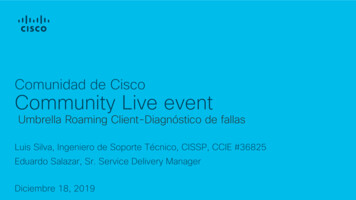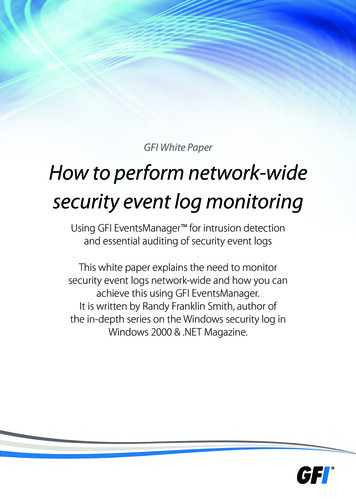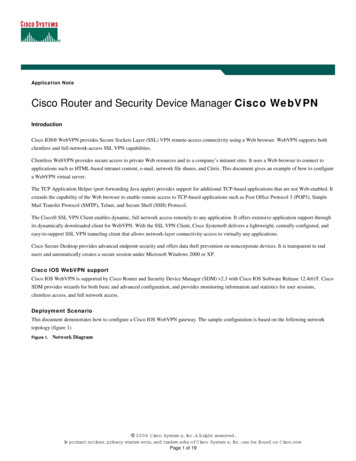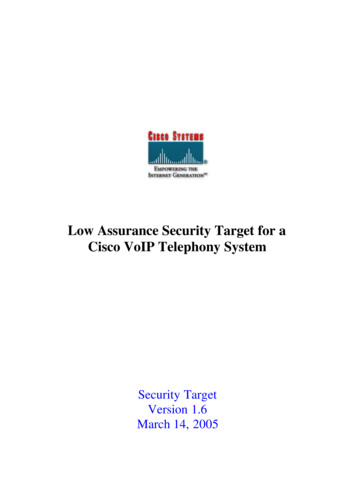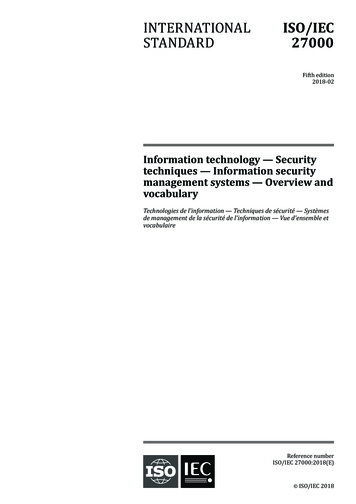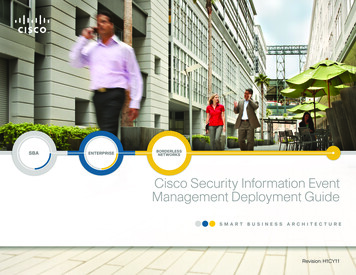
Transcription
Cisco Security Information EventManagement Deployment GuideRevision: H1CY11
The Purpose ofthis DocumentThis guide focuses on Cisco products and discusses how those productsintegrate with any third party SIEM product. It does not cover third partySIEM product configuration details. For third party SIEM product details,refer to the Secure Borderless Networks Technology Partners page:http://www.cisco.com/go/securitypartners Wants to improve IT operational efficiency Wants the assurance of a validated solutionRelated DocumentsRelated ReadingWho Should Read This Guide Has read the Cisco Borderless Networks Enterprise Deployment GuideBN Design Overview Wants to connect Borderless Networks to the Cisco SIEM solution Wants to gain a general understanding of the Cisco SIEM solutionBN Internet Edge Deployment Guide Has a CCNA Security certification or equivalent experience Wants to address compliance and regulatory reporting requirements Wants to enhance network security and operationsBN Internet Edge Configuration GuideDeployment GuidesDesign GuidesDesign OverviewFoundationSupplemental GuidesInternet EdgeConfigurationFilesCisco SIEMUsing this Borderless Networks Guide2You are Here
Table of ContentsIntroduction. . . . . . . . . . . . . . . . . . . . . . . . . . . . . . . . . . . . . . . . . . . . . . . . . . . . . . . . . . . . . . . . 1Using this Cisco SIEM Deployment Guide . . . . . . . . . . . . . . . . . . . . . . . . . . . . . . . 1Business Overview. . . . . . . . . . . . . . . . . . . . . . . . . . . . . . . . . . . . . . . . . . . . . . . . . . . . . . 1Configuration Details . . . . . . . . . . . . . . . . . . . . . . . . . . . . . . . . . . . . . . . . . . . . . . . . . . . . . . 5Cisco Security Information and Event Solution Configuration. . . . . . . . . . . . 5Technoloogy Overview. . . . . . . . . . . . . . . . . . . . . . . . . . . . . . . . . . . . . . . . . . . . . . . . . . . . 2Security Information and Event Management. . . . . . . . . . . . . . . . . . . . . . . . . . . . 2Logging Retrieval Methods . . . . . . . . . . . . . . . . . . . . . . . . . . . . . . . . . . . . . . . . . . . . . . 5Cisco Security Information and Event ManagementSolution Overview. . . . . . . . . . . . . . . . . . . . . . . . . . . . . . . . . . . . . . . . . . . . . . . . . . . . . . . . . 3Cisco SIEM Solution Deployment. . . . . . . . . . . . . . . . . . . . . . . . . . . . . . . . . . . . . . . . . . 4Compliance. . . . . . . . . . . . . . . . . . . . . . . . . . . . . . . . . . . . . . . . . . . . . . . . . . . . . . . . . . . . . . 4Enhanced Network Security and ImprovedIT/Security Operations. . . . . . . . . . . . . . . . . . . . . . . . . . . . . . . . . . . . . . . . . . . . . . . . . . . 4Logging and Time Stamps. . . . . . . . . . . . . . . . . . . . . . . . . . . . . . . . . . . . . . . . . . . . . . . 5Logging Level Details. . . . . . . . . . . . . . . . . . . . . . . . . . . . . . . . . . . . . . . . . . . . . . . . . . . . 5Logging Archives. . . . . . . . . . . . . . . . . . . . . . . . . . . . . . . . . . . . . . . . . . . . . . . . . . . . . . . . 6Rate of Log Generation . . . . . . . . . . . . . . . . . . . . . . . . . . . . . . . . . . . . . . . . . . . . . . . . . . 6Tuning Cisco Infrastructure. . . . . . . . . . . . . . . . . . . . . . . . . . . . . . . . . . . . . . . . . . . . . . . . 7Products Verified with Cisco Smart Business Architecture. . . . . . . . . . . . . . . 14Appendix A: SBA for Enterprise Organizations Document System . . . . . . . 15ALL DESIGNS, SPECIFICATIONS, STATEMENTS, INFORMATION, AND RECOMMENDATIONS (COLLECTIVELY, "DESIGNS") IN THIS MANUAL ARE PRESENTED "AS IS," WITH ALL FAULTS. CISCO AND ITS SUPPLIERSDISCLAIM ALL WARRANTIES, INCLUDING, WITHOUT LIMITATION, THE WARRANTY OF MERCHANTABILITY, FITNESS FOR A PARTICULAR PURPOSE AND NONINFRINGEMENT OR ARISING FROM A COURSE OFDEALING, USAGE, OR TRADE PRACTICE. IN NO EVENT SHALL CISCO OR ITS SUPPLIERS BE LIABLE FOR ANY INDIRECT, SPECIAL, CONSEQUENTIAL, OR INCIDENTAL DAMAGES, INCLUDING, WITHOUT LIMITATION, LOST PROFITS OR LOSS OR DAMAGE TO DATA ARISING OUT OF THE USE OR INABILITY TO USE THE DESIGNS, EVEN IF CISCO OR ITS SUPPLIERS HAVE BEEN ADVISED OF THE POSSIBILITY OF SUCHDAMAGES. THE DESIGNS ARE SUBJECT TO CHANGE WITHOUT NOTICE. USERS ARE SOLELY RESPONSIBLE FOR THEIR APPLICATION OF THE DESIGNS. THE DESIGNS DO NOT CONSTITUTE THE TECHNICALOR OTHER PROFESSIONAL ADVICE OF CISCO, ITS SUPPLIERS OR PARTNERS. USERS SHOULD CONSULT THEIR OWN TECHNICAL ADVISORS BEFORE IMPLEMENTING THE DESIGNS. RESULTS MAY VARYDEPENDING ON FACTORS NOT TESTED BY CISCO.Any Internet Protocol (IP) addresses used in this document are not intended to be actual addresses. Any examples, command display output, and figures included in the document are shown for illustrative purposesonly. Any use of actual IP addresses in illustrative content is unintentional and coincidental. Cisco Unified Communications SRND (Based on Cisco Unified Communications Manager 7.x) 2010 Cisco Systems, Inc. All rights reserved.Table of Contents
IntroductionThe Smart Business Architecture – Borderless Networks for EnterpriseOrganizations incorporates many parts, including firewalls, routers, intrusiondetection systems (IDS), intrusion prevention systems (IPS), and other deviceswhose proper operation is essential to the security of the network. These devicesmay produce significant amounts of event logs and other security-relevantinformation. Security information and event management (SIEM) products aredesigned to make the task of collecting, correlating, and acting on this information easier. This guide is a supplement to the Smart Business Architecture– Borderless Networks for Enterprise Organizations architecture, and should beread together with the LAN, WAN, and Internet Edge Deployment Guides; Figure1 shows how a SIEM integrates into the overall architecture.application integration, and a wide variety of networked devices. As the environment becomes more complex, organizations face growing security challengeswith complex regulatory requirements that force them to effectively monitor andreport security incidents. Organizations face business challenges in the area ofcompliance, enhanced network security, IT and security operations.Figure 1. SIEM Placement in the Smart Business Architecture – BorderlessNetworks for Enterprise OrganizationsUsing this Cisco SIEM Deployment GuideThis guide provides a general overview of SIEM technology, as well as bestpractices, use cases, and deployment considerations for using a SIEM with Ciscoinfrastructure. This guide is intended to be used together with one of the partnerSIEM deployment guides, which contains deployment steps and configurationsspecific to that partner’s product. (Note: In this guide, “Cisco infrastructure” isused to include firewalls, routers, IDS, IPS, and other systems that are sources ofsecurity event information.)The Business Overview section of this document outlines the business problemsfaced by enterprise organizations in managing, storing, tracking, and usingsecurity information and event logs. The Technology Overview provides detailson fundamental SIEM concepts and important considerations when evaluatingSIEM solutions. The guide introduces the Cisco SIEM solution, and describeshow this solution fits in the Smart Business Architecture – Borderless Networksfor Enterprise Organizations and how it solves business problems of enterpriseorganizations. The Configuration Details section discusses best practices andthe steps required to deploy Cisco infrastructure with a SIEM partner product.Business OverviewIncreasing employee mobility, use of video, and globalization are changingthe IT environment. Traditional enterprises that once viewed themselves asdistinct entities with a clearly defined perimeter are now shifting to a borderlessmodel. The borderless model allows cloud-based services, workplace mobility,The first challenge for the organization is to comply with regulatory requirements, as well as its own internal policies. Customers need the ability to log,monitor, and report on security incidents in their data infrastructure, and tolog, store, and report on large volumes of security event logs. Organizationsfind themselves having to deal with massive amounts of data being generated by their infrastructure every day.The second challenge involves enhancing network security of the organization. With threats constantly coming from outside and inside the organization, it is increasingly difficult to weed through the noise of routine securityevents and determine which threats warrant investigation. Economic pressures to do more with less staff only compound the problem.Finally, gathering logs from devices and applications throughout the enterprise can be very costly. Managing the sheer volume of raw logs and events,both in real time and from for long term archive storage is a major effort.Security investigations can require searching many different networkedsystems and piecing together fragmented bits of information stored in avariety of incompatible formats. Organizations need a unified view of thestate of network security in a single dashboard.Introduction1
Technology OverviewSecurity Information and Event ManagementSIEM technology is used in many enterprise organizations to provide realtime reporting and long term analysis of security events. SIEM productsevolved from two previously distinct product categories, namely securityinformation management (SIM) and security event management (SEM).Table 1 shows this evolution.Table 1. SIM and SEM Product Features Incorporated into SIEMSeparate SIM and SEM ProductsSecurity Information Management:Security Event Management:Log collection, archiving, historicalreporting, forensicsReal time reporting, logcollection, normalization,correlation, aggregationCombined SIEM ProductLog tingSIEM combines the essential functions of SIM and SEM products to provide acomprehensive view of the enterprise network using the following functions: Log collection of event records from sources throughout the organization provides important forensic tools and helps to address compliancereporting requirements. Normalization maps log messages from different systems into a commondata model, enabling the organization to connect and analyze relatedevents, even if they are initially logged in different source formats. Correlation links logs and events from disparate systems or applications,speeding detection of and reaction to security threats. Aggregation reduces the volume of event data by consolidating duplicate event records. Reporting presents the correlated, aggregated event data in real-timemonitoring and long-term summaries.Technology Overview2
Cisco SIEMSolution OverviewOrganizations have a major investment in Cisco technology, and rely onCisco to provide secure, robust, scalable, and interoperable solutions.Cisco is partnering with leading companies through the Cisco DeveloperNetwork (CDN) to deliver a SIEM solution that meets the diverse securityand reporting needs of organizations. This integration enables customersto select the SIEM tools best suited to their own environments andrequirements, and take full advantage of the capabilities of their Cisconetwork infrastructure.The SIEM partners’ products complement the Cisco Security ManagementSuite, including Cisco Security Manager and Cisco Security MARS, toprovide support for enhanced operational use cases.The SIEM solution is part of the Cisco Smart Business Architecture –Borderless Networks for Enterprise Organizations design, which offerspartners and customers valuable network design and deployment bestpractices, and helps organizations deliver superior end-user experienceson their networks.Cisco SIEM Solution Overview3
Cisco SIEM SolutionDeploymentThe SIEM market is evolving towards integration with business managementtools, internal fraud detection, geographical user activity monitoring, contentmonitoring, and business critical application monitoring. SIEM systems areimplemented for compliance reporting, enhanced analytics, forensic discovery, automated risk assessment, and threat mitigation.ComplianceCompliance with monitoring and reporting regulations is often a significantfactor in the decision to deploy a SIEM system. Other policy requirements ofa specific organization may also play a role. Examples of regulatory requirements include the Health Insurance Portability and Accountability Act(HIPAA) for health care providers in the United States, or the Payment CardIndustry’s Data Security Standard (PCI-DSS) for organizations that handlepayment card information. A SIEM can help the organization to comply withmonitoring mandates and document their compliance to auditors.Enhanced Network Security and ImprovedIT/Security OperationsAttacks against network assets are a daily occurrence for many organizations. Attack sources can be inside or outside the organization’s network.As the boundaries of the enterprise network expand, the role of networksecurity infrastructure must expand as well.For example, when an employee laptop becomes infected by malware, itmay discover other systems on the corporate network, and then attempt toattack those systems, spreading the infection. Each system under attackcan report the malicious activity to the SIEM. The SIEM system can correlate those individual reports into a single alert that identifies the originalinfected system and its attempted targets. In this case, the SIEM’s ability tocollect and correlate logs of failed authentication attempts allows securityoperations personnel to determine which system is infected, so that it canbe isolated from the network until the malware is removed. In some cases,it may be possible to use information from a switch or other network accessdevice to automatically disable the network connection until remediationtakes place.The SIEM can provide this information in both real-time alerts and historicalreports that summarize the security status of the enterprise network over alarge data collection, typically on the order of months rather than days. Thishistorical perspective enables the security administrators to establish abaseline for normal network operations, so they can focus their daily efforton any new or abnormal security events.Typically, security operations staff deploys many security measures, suchas firewalls, IDS sensors, IPS appliances, web and email content protection,and network authentication services. All of these can generate significantamounts of information, which the security operations staff can use toidentify threats that could harm network security and operations.Cisco SIEM Solution Deployment4
Configuration DetailsCisco Security Information and Event Solution ConfigurationEnterprise organizations have different business models and thereforedifferent logging requirements, but all should have a policy regarding thecapturing, storing, archiving, and monitoring of logs from network infrastructure devices, systems and applications.This section outlines some of the high-level best practices and sampleconfigurations for enabling logging on Cisco network infrastructure devices.You should understand the following areas before enabling logging:Table 2. Logging MethodsSecurity DeviceLogging MethodProtocol DetailsCisco IOS-basedroutersyslogUDP port 514Cisco ASA 5500 SeriessyslogUDP port 514 or TCPport 1468Cisco IPS 4200 SeriesSDEEHTTP or HTTPSCisco Security MARSRaw message archiveSFTP or NFSCisco IronPort EmailSecurity ApplianceLog file exportSCP or FTPCisco IronPort WebSecurity ApplianceLog file exportSCP or FTP Logging and time stamps Logging retrieval methods Logging level detailsTech Ti p Rate of log generation Logging archivesLogging and Time StampsThe exact time at which a security event occurred is important information, and may need to be correlated across several different devices. TheNetwork Time Protocol (NTP) should be configured wherever possible tosynchronize time across networks, applications, and systems.Logging Retrieval MethodsThe following table shows the logging methods for each type of securitydevice that is addressed in this guide:Tech Tip: Use TCP-based syslog where possible, because TCP deliveryis reliable, and data forwarding will stop if the device cannot write to logservers.Logging Level DetailsStandard syslog implementations define eight severity levels for messages,identfied by a number from zero to seven, with lower severities representingmore severe or important events. The configured log level determines thelowest priority message that is eligible to be logged. For example, if the loglevel is set to 5 for notifications, messages of level 6 or 7 are not logged.Unless specifically required, avoid setting the log level to 7, becausedebugging level messages create significant extra traffic, usually of littlesecurity interest. A device’s logging level should be chosen to strike abalance between collecting enough information to meet security requirements,while keeping overall impact on systems and network resources as lowas possible.Configuration Details5
Table 3. Syslog Message LevelsLogLevelSeverity KeywordMeaningDefault BehavioremergenciesSystem isunusableloggedalertsImmediate actionneededlogged2criticalCritical conditionslogged3errorsError ificationsNormal tionalmessagesloggeddebuggingDebuggingmessagesnot logged014567Logging ArchivesLog management solutions need to have a substantial amount of storage tohold all of the log messages. Some regulations may require organizations tokeep logs for a certain number of days or months or years.Rate of Log GenerationThe volume of traffic flowing through your network, the complexity of yourpolicy rules, and the logging configuration of your devices will affect theamount of security information that is logged. Excessive logging can causeperformance problems, increase network load, and make it harder to extractuseful information from the SIEM product. Log levels should be set according to the importance of the assets being protected, and will vary accordingto each organization’s environment and requirements. For example, adatabase administrator might enable extensive auditing and logging on acritical financial application, and lower levels for most other applications. Tohelp understand the actual volume of logs generated, it can be helpful to setup a syslog receiver on a separate system, and monitor the rate of incomingmessages. Also keep in mind that the amount of information logged duringan attack may increase significantly compared to normal levels.Configuration Details6
Tuning Cisco InfrastructureThe following processes show how to configure your Cisco securityinfrastructure components to send log messages and event recordsto the SIEM system.For more aggressive tuning, you may also consider disabling the followingmessages:302014: A TCP connection between two hosts was deleted302016: A UDP connection slot between two hosts was deletedProcessTuning Cisco ASA 5500 Adaptive Security Appliances1. Syslog Message TuningProcedure 1At logging level Informational, Cisco recommends disabling the followingmessages, as they are of little interest for SIEM analysis:305010: The address translation slot was deleted305011: A TCP, UDP, or ICMP address translation slot wascreated305012: The address translation slot was deletedTo disable these messages, use the following configurationcommands:no logging message 305010no
factor in the decision to deploy a SIEM system. Other policy requirements of a specific organization may also play a role. Examples of regulatory require-ments include the Health Insurance Portability and Accountability Act (HIPAA) for health
